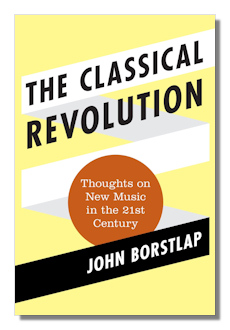
The Internet's Premier Classical Music Source
Related Links
-
Introduction
Acoustics
Ballet
Biographies
Chamber Music
Composers & Composition
Conducting
Criticism & Commentary
Discographies & CD Guides
Fiction
History
Humor
Illustrations & Photos
Instrumental
Lieder
Music Appreciation
Music Education
Music Industry
Music and the Mind
Opera
Orchestration
Reference Works
Scores
Thematic Indices
Theory & Analysis
Vocal Technique
Search Amazon
Recommended Links
Site News
 Book Review
Book Review
The Classical Revolution

Thoughts on New Music in the 21st Century
John Borstlap
Modern Traditionalist Classical Music Series
Scarecrow Press, 2013.
147 pages cloth. Alkaline paper
ISBN-10: 0810884577
ISBN-13: 978-0810884571
ISBN:978-0-8108-8458-8 (ebook)
Borstlap's book is described by the publisher as a "polemic." Anyone who ever had to read Cicero's Oration Against Cataline knows what a polemic is but for some others a dictionary definition will may be in order: "a controversial argument, especially one refuting or attacking a specific opinion or doctrine." Collins Thesaurus of the English Language offers amplification of the adjective "polemical": "acerbic", "cutting," "caustic," "contentious", "vitriolic", and more. Of course, to enjoy this form of discourse, a necessary condition is that one generally agrees with the one uttering it. This is not a sufficient condition, to be sure. One might agree with the gist of what is said but not the way it is argued. Many people enjoy polemics, if only measured by the millions of listeners to certain political commentators. And as the majority of music lovers will share Borstlap's musical preferences he is probably assured of having sympathetic readers.
That said, what is Borstlap attacking? His enemy is "atonal music," or, more correctly, the sounds that proponents call atonal music. He makes the very strong claim, by which may be called a stipulative definition, or a dogmatic assertion if you prefer, that anything that deserves to be called music is tonal, in effect that there is no such thing as atonal music. He offers an alternative term for our consideration, "sonic art," to replace the term "atonal music." Note that he does give it the status of art, presumably taking account of discussions at the height of the avant-garde in the last century, by writers on aesthetics, attempting to keep up with developments in cultural institutions. (George Dickie, for instance, in Art and the Aesthetic, An Instituional Analysis, went so far as to argue that a work of art can be defined as any artifact "aspects of which has had conferred on it the status of candidate for appreciation" on behalf of the institutionalized artworld).
Accordingly, Borstlap can be seen to protect himself from attack on philosophical grounds.. Whether his proposed terms will ever become current is a wait and see matter. A definition of music as "organized sound" is certainly more current. But in his book he offers an instance, (from the Netherlands where he lives) of traditional tonal music and "tonal art" actually being presented in different venues for different audiences.
The place from which Borstlap is writing is significant. He claims that in the Netherlands, even at the present time, musical performances of new works generally depend on financial grants from the government. Further, he says the grants are routinely awarded on the recommendations of non-governmental groups or committees that are completely in the hands of atonalists. As a tonal composer himself he is understandably out of sorts with this situation. Hence this book.
Bortlap offers factual evidence that many music lovers not only avoid concerts featuring atonal music – I hope I may be forgiven for not using his preferred term – they also avoid concerts in which any new music – even new tonal music – is offered. Certainly many orchestra administrators would agree with this, rightly or wrongly, although some informed observers of the musical scene might have a different view of the matter.
Borstlap's suggestion to change this situation of the reluctant audience is one I happen to agree with, though I am not sure it is consistent with his general angry pessimism. The solution is more good new tonal music. He offers examples of composers of such music in his chapter "Nine. Some Composers." Most of them are new to me, with the exception of David Matthews, whom I am aware of because he was invited to complete the slow movement of Ralph Vaughan Williams' Cello Concerto, left unfinished at RVW's death. As Dark Pastoral for Cello and Orchestra, this was performed at the Proms in London and recently released on a recording of RVW' Early and Late Works (which I have reviewed here.) Matthews' own works include violin concertos, an Oboe Concerto, and a piece called After Sunrise which appear on a Dutton Epoch CD. Another of Borstlap's recommended composers is Nicolas Bacri, a prolific French composer, one unknown to me until recently, when I received a disc for review of music performed by the Zodiac Trio. A Smiling Suite on this disc is neoclassical. If Borstlap had devoted half his book to the eleven composers he recommends, he might have produced a more useful and appealing work.
Copyright © 2013, R. James Tobin



















